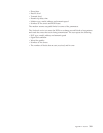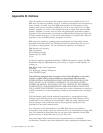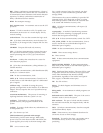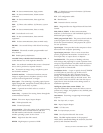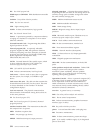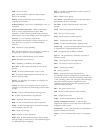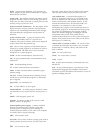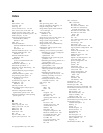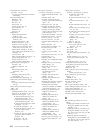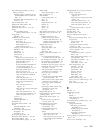BSC. Binary synchronous communications. A form of
telecommunication line control that uses a standard set
of transmission control characters and control character
sequences, for binary synchronous transmission of
binary coded data between stations.
BTM. Bus transport message.
basic assurance test. An automatic test to test the I/O
processor.
browse. To look at records in a file. To rapidly scan
information on the screen of a visual display unit by
vertical scrolling.
card enclosure. The area that contains the logic cards.
CD. (1) In data communications, carrier detector. See
also RLSD. (2) In storage media, compact disk. See also
CD-ROM.
CD-ROM. Compact disk-read only memory.
CEC. (1) In data communications, connect data set to
line. (2) Central electronics complex (formerly called
central processing unit or CPU). (3) Card enclosure
cage.
checksum. A utility that writes data in a sector for
error detection purposes.
CI. (1) In data communications, calling indicator. (2)
Callable interface.
CID. In data communications, cable identification (ID)
usually for a common return.
CLK. In data communications, clock.
CNTL A, B. In data communications, Control A or B.
A and B refer to each individual signal of a differential
pair of signals.
collision wrap. A method of testing the power,
ground, and signal lines on the interface of an Ethernet
adapter. This test requires the use of specialized wrap
connectors.
concurrent maintenance. The process of removing or
replacing hardware while the system is in use.
configure. To describe to a system the devices,
optional features, and programs installed on the
system.
confirm. To remove doubt about any authoritative act
or indisputable fact.
cpi. See characters per inch.
CPM (continuously powered main storage).
Continuously powered main storage. When utility
power is lost on some iSeries models with SPCN, the
system applies power only to the main storage cards
for a varied amount of time (for example, one day).
This process is called continuously powered main
storage (CPM).
CPM increases the system availability. It provides full
operating power for a short time to allow a system
shut-down procedure. CPM allows the customer data
to be stored and minimizes recovery time.
CRQ. (1) In data communications, call request. (2)
Change request.
cryptography. A method of transforming customer
data to conceal its meaning. Cryptographic services
include data encryption and message
CTL A, B. In data communications, control. See CNTL.
CTS, CTSA, CTSB. In data communications, clear to
send (A and B refer to each individual signal of a
differential pair of signals).
CTSB. In data communications, clear to send B.
DASD. Direct access storage device.
dc. Direct current.
DCE. In data communications, data communications
equipment.
DCLK, DCLKA, DCLKB. In data communications,
data clock (A and B refer to each individual signal of a
differential pair of signals).
DDI. Distributed data interface. The term DDI is used
to represent all local area network (LAN) types based
on the fiber distributed data interface (FDDI)
specifications, regardless of the media used (optical
fiber, copper, or shielded twisted pair).
DE. See disk enclosure.
debug. To check diagnose and eliminate errors in
programs.
debug mode. An environment in which programs can
be tested.
dedicated service tools (DST). The part of the service
functions used to service the system.
disk enclosure. The part of a disk unit that contains
the read and write heads, the magnetic disks, and the
actuators.
DLO. (1) In data communications, data line occupied.
(2) Document library object.
DMA. Direct memory access channel (hardware for
I/O device access to main storage).
download. To transfer data from a processing unit to
an attached device, such as a microcomputer, for
processing.
326 Service Functions V5R2




